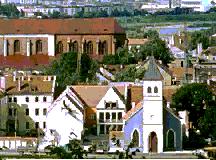 You
can meet Lithuanian forms in all books and publications about the Proto-Indo-European
language. That is true, Lithuanian is very conservative and can be used
as an example of a pure Indo-European language. It has not many borrowed
words (much less than English, German or Russian), very complicated flexion
system of substantives, pronouns and verbs and practically no signs of
"analitization" which struck some modern Indo-European languages, such
as English or French.
You
can meet Lithuanian forms in all books and publications about the Proto-Indo-European
language. That is true, Lithuanian is very conservative and can be used
as an example of a pure Indo-European language. It has not many borrowed
words (much less than English, German or Russian), very complicated flexion
system of substantives, pronouns and verbs and practically no signs of
"analitization" which struck some modern Indo-European languages, such
as English or French.
Lithuanian is not very old comparing to Greek and Latin, but it also has its long history. It was born by the union of Baltic tribes under the princes of Mindaugas's dynasty in the 13th century to contain German Teutonic aggression. At that moment Lithuanian was full of small dialects, but since the country was strengthening the central dialects slowly assimilated those of Baltic shore, of rural regions and even some other Baltic minor languages including Curonian.
But dialects exist even now. Although a literary language had existed since the 16th century, three literary dialects competed for acceptance in the 19th century; modern Standard Lithuanian (based on the West High Lithuanian dialect) did not develop fully until just before the first period of Lithuanian political independence (1918-40), when it became the country's official language. Lithuanian suffered great influence from Slavic languages, mostly Polish and Russian, and also borrowed some words from Finno-Ugric tribes who used to live north from them, but still Lithuanian has preserved its purity.
Lithuanian is highly inflected. In standard Lithuanian, nouns have seven cases (some dialects have eight with ablative). Gender is masculine and feminine, although some traces of the old neuter survive (mostly in adjectives). Number is singular and plural; classical Lithuanian used to have, and some dialects even now have a dual number (for two items). The article is not used. Four simple verb tenses (present, preterite, frequentive past, and future) and several compounds exist in the indicative mood; imperative, subjunctive, reflexive, infinitive, and participial forms are also clearly defined. The language is rich in the use of diphthongs and, like Latvian, in rising and falling intonations, which is a characteristic feature of the Baltic group. Lithuanian is written in the Latin alphabet, with additional diacritical marks.
As there is not much on the Web about the Lithuanian language, we included
The Historical Grammar of Lithuanian language into our Indo-European section
so you can easily see what modern and ancient Lithuanian look like.